Critical Appraisal of a Research Article: Browning & Cruz (2018)
VerifiedAdded on 2022/09/28
|8
|2171
|39
Report
AI Summary
This report provides a critical appraisal of the research article by Browning and Cruz (2018), which investigates reflective debriefing as a social work intervention to reduce moral distress among ICU nurses. The appraisal examines the literature review, research problem, purpose, research questions, theoretical framework, and research design. The report identifies strengths and weaknesses within the study's methodology, including the clarity of the abstract, the support provided by the literature review, and the presence of a clear research question. The author's qualifications are assessed, and the study's variables and research design are evaluated for their appropriateness. The appraisal concludes with an overall assessment of the study's value and reliability, offering insights into its potential for practical application in clinical settings. The report highlights the importance of addressing moral distress among ICU nurses and the potential benefits of reflective debriefing interventions.
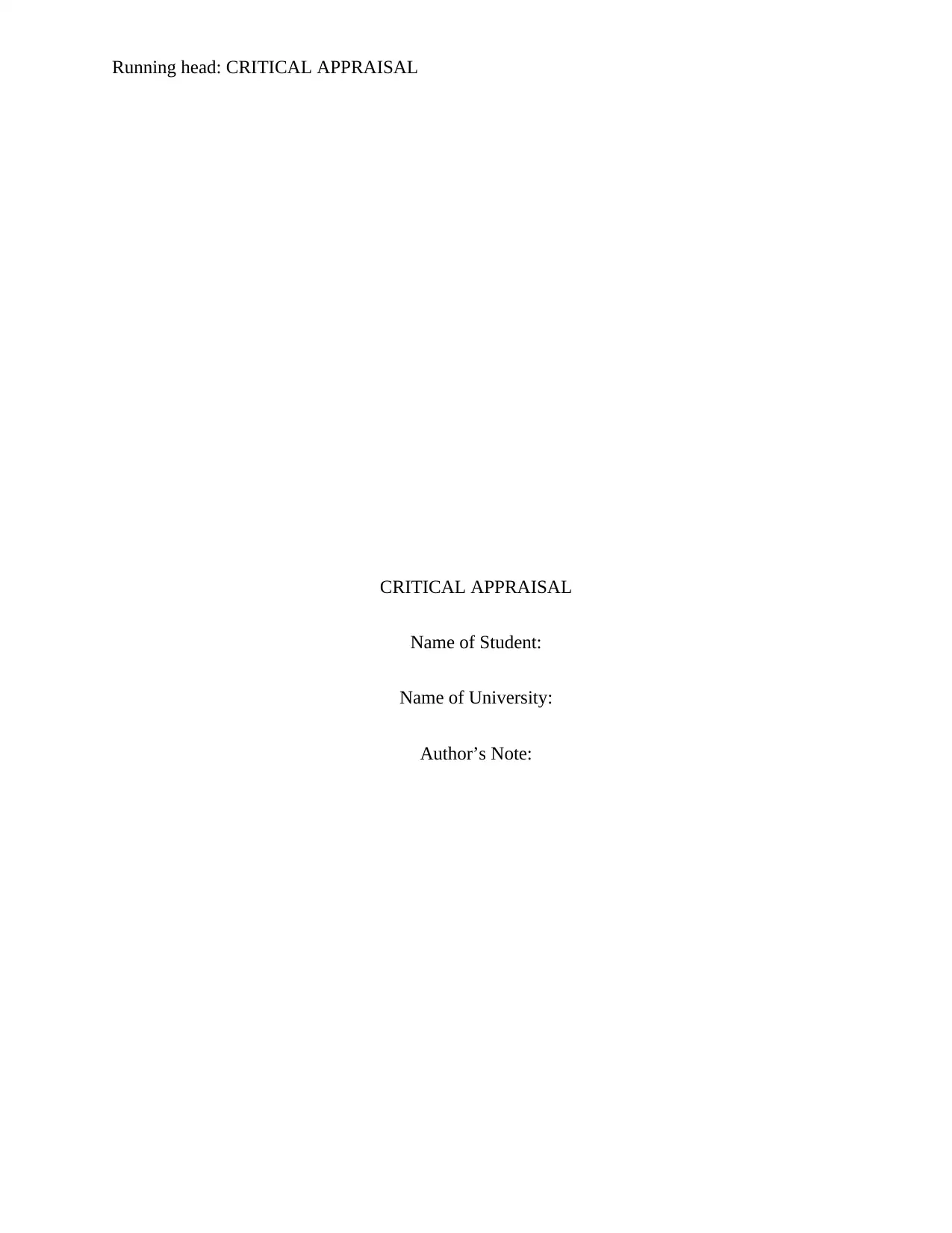
Running head: CRITICAL APPRAISAL
CRITICAL APPRAISAL
Name of Student:
Name of University:
Author’s Note:
CRITICAL APPRAISAL
Name of Student:
Name of University:
Author’s Note:
Paraphrase This Document
Need a fresh take? Get an instant paraphrase of this document with our AI Paraphraser
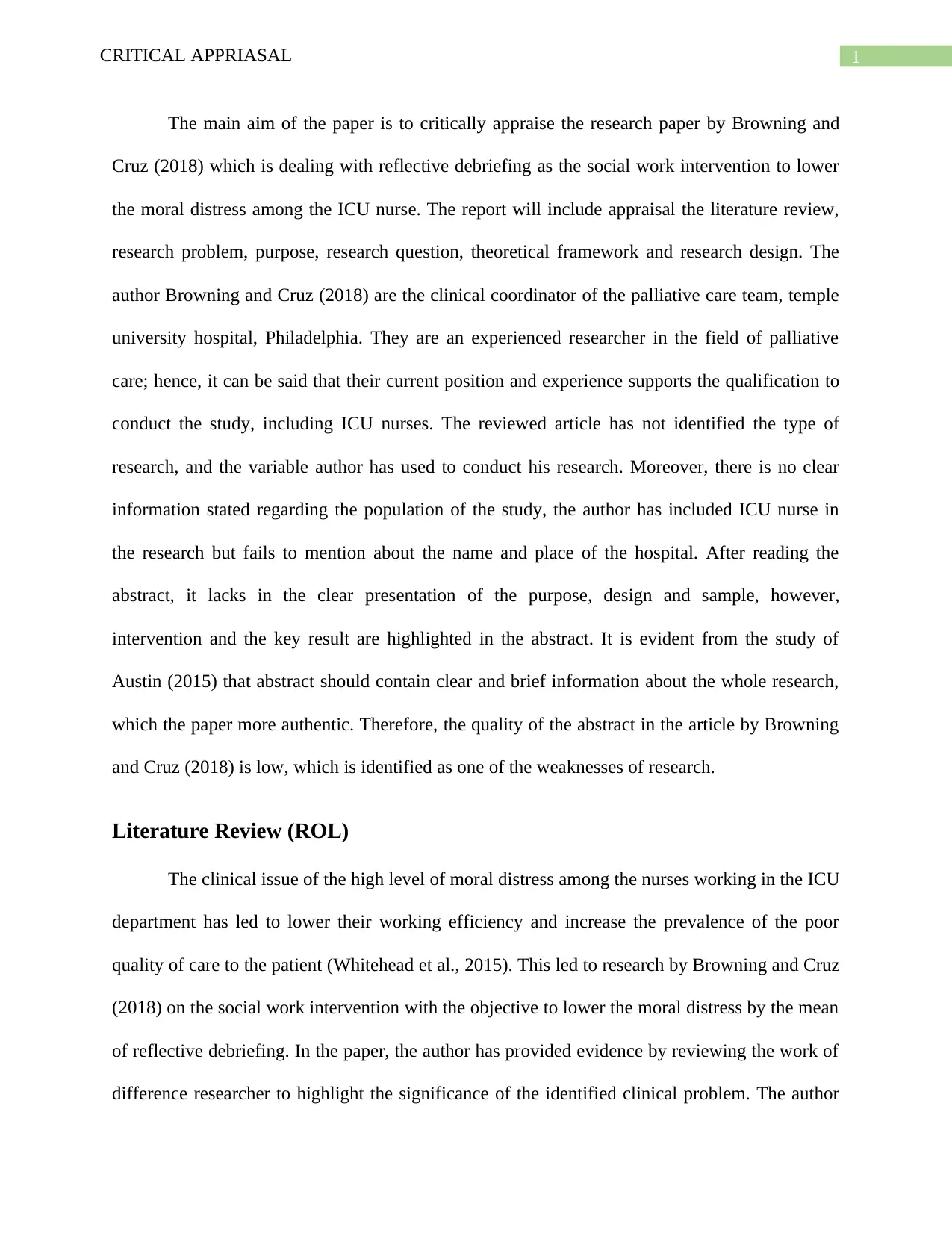
1CRITICAL APPRIASAL
The main aim of the paper is to critically appraise the research paper by Browning and
Cruz (2018) which is dealing with reflective debriefing as the social work intervention to lower
the moral distress among the ICU nurse. The report will include appraisal the literature review,
research problem, purpose, research question, theoretical framework and research design. The
author Browning and Cruz (2018) are the clinical coordinator of the palliative care team, temple
university hospital, Philadelphia. They are an experienced researcher in the field of palliative
care; hence, it can be said that their current position and experience supports the qualification to
conduct the study, including ICU nurses. The reviewed article has not identified the type of
research, and the variable author has used to conduct his research. Moreover, there is no clear
information stated regarding the population of the study, the author has included ICU nurse in
the research but fails to mention about the name and place of the hospital. After reading the
abstract, it lacks in the clear presentation of the purpose, design and sample, however,
intervention and the key result are highlighted in the abstract. It is evident from the study of
Austin (2015) that abstract should contain clear and brief information about the whole research,
which the paper more authentic. Therefore, the quality of the abstract in the article by Browning
and Cruz (2018) is low, which is identified as one of the weaknesses of research.
Literature Review (ROL)
The clinical issue of the high level of moral distress among the nurses working in the ICU
department has led to lower their working efficiency and increase the prevalence of the poor
quality of care to the patient (Whitehead et al., 2015). This led to research by Browning and Cruz
(2018) on the social work intervention with the objective to lower the moral distress by the mean
of reflective debriefing. In the paper, the author has provided evidence by reviewing the work of
difference researcher to highlight the significance of the identified clinical problem. The author
The main aim of the paper is to critically appraise the research paper by Browning and
Cruz (2018) which is dealing with reflective debriefing as the social work intervention to lower
the moral distress among the ICU nurse. The report will include appraisal the literature review,
research problem, purpose, research question, theoretical framework and research design. The
author Browning and Cruz (2018) are the clinical coordinator of the palliative care team, temple
university hospital, Philadelphia. They are an experienced researcher in the field of palliative
care; hence, it can be said that their current position and experience supports the qualification to
conduct the study, including ICU nurses. The reviewed article has not identified the type of
research, and the variable author has used to conduct his research. Moreover, there is no clear
information stated regarding the population of the study, the author has included ICU nurse in
the research but fails to mention about the name and place of the hospital. After reading the
abstract, it lacks in the clear presentation of the purpose, design and sample, however,
intervention and the key result are highlighted in the abstract. It is evident from the study of
Austin (2015) that abstract should contain clear and brief information about the whole research,
which the paper more authentic. Therefore, the quality of the abstract in the article by Browning
and Cruz (2018) is low, which is identified as one of the weaknesses of research.
Literature Review (ROL)
The clinical issue of the high level of moral distress among the nurses working in the ICU
department has led to lower their working efficiency and increase the prevalence of the poor
quality of care to the patient (Whitehead et al., 2015). This led to research by Browning and Cruz
(2018) on the social work intervention with the objective to lower the moral distress by the mean
of reflective debriefing. In the paper, the author has provided evidence by reviewing the work of
difference researcher to highlight the significance of the identified clinical problem. The author
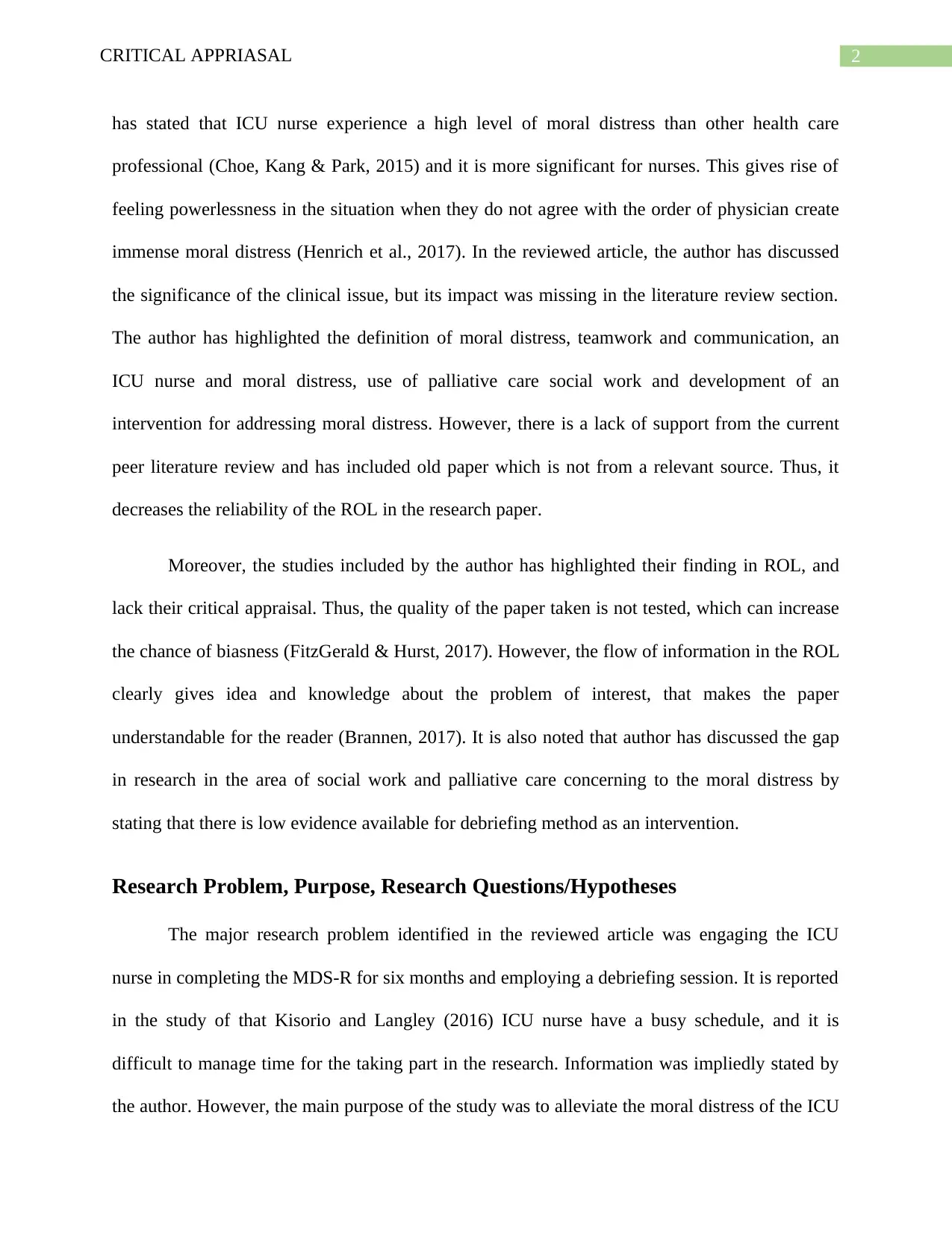
2CRITICAL APPRIASAL
has stated that ICU nurse experience a high level of moral distress than other health care
professional (Choe, Kang & Park, 2015) and it is more significant for nurses. This gives rise of
feeling powerlessness in the situation when they do not agree with the order of physician create
immense moral distress (Henrich et al., 2017). In the reviewed article, the author has discussed
the significance of the clinical issue, but its impact was missing in the literature review section.
The author has highlighted the definition of moral distress, teamwork and communication, an
ICU nurse and moral distress, use of palliative care social work and development of an
intervention for addressing moral distress. However, there is a lack of support from the current
peer literature review and has included old paper which is not from a relevant source. Thus, it
decreases the reliability of the ROL in the research paper.
Moreover, the studies included by the author has highlighted their finding in ROL, and
lack their critical appraisal. Thus, the quality of the paper taken is not tested, which can increase
the chance of biasness (FitzGerald & Hurst, 2017). However, the flow of information in the ROL
clearly gives idea and knowledge about the problem of interest, that makes the paper
understandable for the reader (Brannen, 2017). It is also noted that author has discussed the gap
in research in the area of social work and palliative care concerning to the moral distress by
stating that there is low evidence available for debriefing method as an intervention.
Research Problem, Purpose, Research Questions/Hypotheses
The major research problem identified in the reviewed article was engaging the ICU
nurse in completing the MDS-R for six months and employing a debriefing session. It is reported
in the study of that Kisorio and Langley (2016) ICU nurse have a busy schedule, and it is
difficult to manage time for the taking part in the research. Information was impliedly stated by
the author. However, the main purpose of the study was to alleviate the moral distress of the ICU
has stated that ICU nurse experience a high level of moral distress than other health care
professional (Choe, Kang & Park, 2015) and it is more significant for nurses. This gives rise of
feeling powerlessness in the situation when they do not agree with the order of physician create
immense moral distress (Henrich et al., 2017). In the reviewed article, the author has discussed
the significance of the clinical issue, but its impact was missing in the literature review section.
The author has highlighted the definition of moral distress, teamwork and communication, an
ICU nurse and moral distress, use of palliative care social work and development of an
intervention for addressing moral distress. However, there is a lack of support from the current
peer literature review and has included old paper which is not from a relevant source. Thus, it
decreases the reliability of the ROL in the research paper.
Moreover, the studies included by the author has highlighted their finding in ROL, and
lack their critical appraisal. Thus, the quality of the paper taken is not tested, which can increase
the chance of biasness (FitzGerald & Hurst, 2017). However, the flow of information in the ROL
clearly gives idea and knowledge about the problem of interest, that makes the paper
understandable for the reader (Brannen, 2017). It is also noted that author has discussed the gap
in research in the area of social work and palliative care concerning to the moral distress by
stating that there is low evidence available for debriefing method as an intervention.
Research Problem, Purpose, Research Questions/Hypotheses
The major research problem identified in the reviewed article was engaging the ICU
nurse in completing the MDS-R for six months and employing a debriefing session. It is reported
in the study of that Kisorio and Langley (2016) ICU nurse have a busy schedule, and it is
difficult to manage time for the taking part in the research. Information was impliedly stated by
the author. However, the main purpose of the study was to alleviate the moral distress of the ICU
⊘ This is a preview!⊘
Do you want full access?
Subscribe today to unlock all pages.

Trusted by 1+ million students worldwide
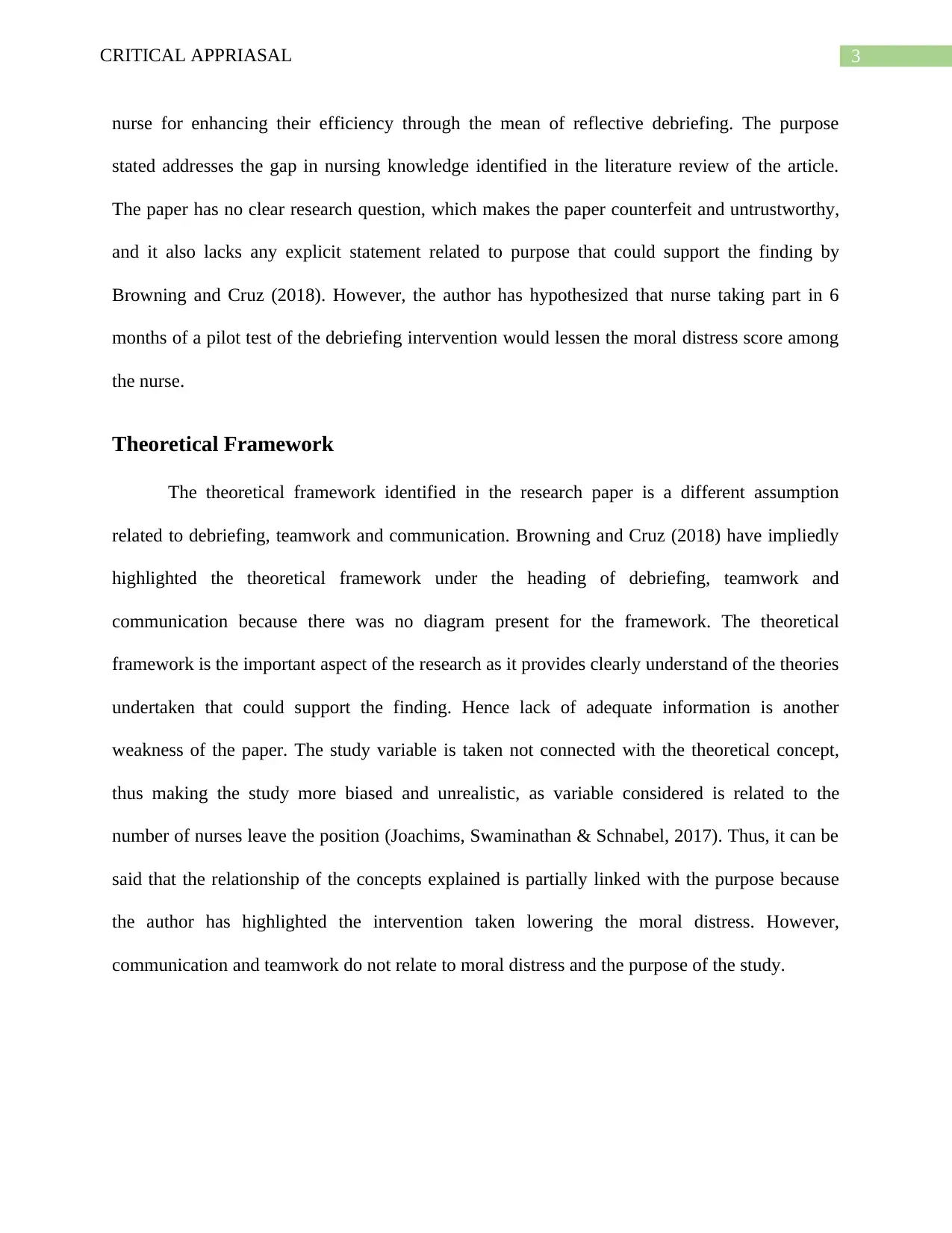
3CRITICAL APPRIASAL
nurse for enhancing their efficiency through the mean of reflective debriefing. The purpose
stated addresses the gap in nursing knowledge identified in the literature review of the article.
The paper has no clear research question, which makes the paper counterfeit and untrustworthy,
and it also lacks any explicit statement related to purpose that could support the finding by
Browning and Cruz (2018). However, the author has hypothesized that nurse taking part in 6
months of a pilot test of the debriefing intervention would lessen the moral distress score among
the nurse.
Theoretical Framework
The theoretical framework identified in the research paper is a different assumption
related to debriefing, teamwork and communication. Browning and Cruz (2018) have impliedly
highlighted the theoretical framework under the heading of debriefing, teamwork and
communication because there was no diagram present for the framework. The theoretical
framework is the important aspect of the research as it provides clearly understand of the theories
undertaken that could support the finding. Hence lack of adequate information is another
weakness of the paper. The study variable is taken not connected with the theoretical concept,
thus making the study more biased and unrealistic, as variable considered is related to the
number of nurses leave the position (Joachims, Swaminathan & Schnabel, 2017). Thus, it can be
said that the relationship of the concepts explained is partially linked with the purpose because
the author has highlighted the intervention taken lowering the moral distress. However,
communication and teamwork do not relate to moral distress and the purpose of the study.
nurse for enhancing their efficiency through the mean of reflective debriefing. The purpose
stated addresses the gap in nursing knowledge identified in the literature review of the article.
The paper has no clear research question, which makes the paper counterfeit and untrustworthy,
and it also lacks any explicit statement related to purpose that could support the finding by
Browning and Cruz (2018). However, the author has hypothesized that nurse taking part in 6
months of a pilot test of the debriefing intervention would lessen the moral distress score among
the nurse.
Theoretical Framework
The theoretical framework identified in the research paper is a different assumption
related to debriefing, teamwork and communication. Browning and Cruz (2018) have impliedly
highlighted the theoretical framework under the heading of debriefing, teamwork and
communication because there was no diagram present for the framework. The theoretical
framework is the important aspect of the research as it provides clearly understand of the theories
undertaken that could support the finding. Hence lack of adequate information is another
weakness of the paper. The study variable is taken not connected with the theoretical concept,
thus making the study more biased and unrealistic, as variable considered is related to the
number of nurses leave the position (Joachims, Swaminathan & Schnabel, 2017). Thus, it can be
said that the relationship of the concepts explained is partially linked with the purpose because
the author has highlighted the intervention taken lowering the moral distress. However,
communication and teamwork do not relate to moral distress and the purpose of the study.
Paraphrase This Document
Need a fresh take? Get an instant paraphrase of this document with our AI Paraphraser
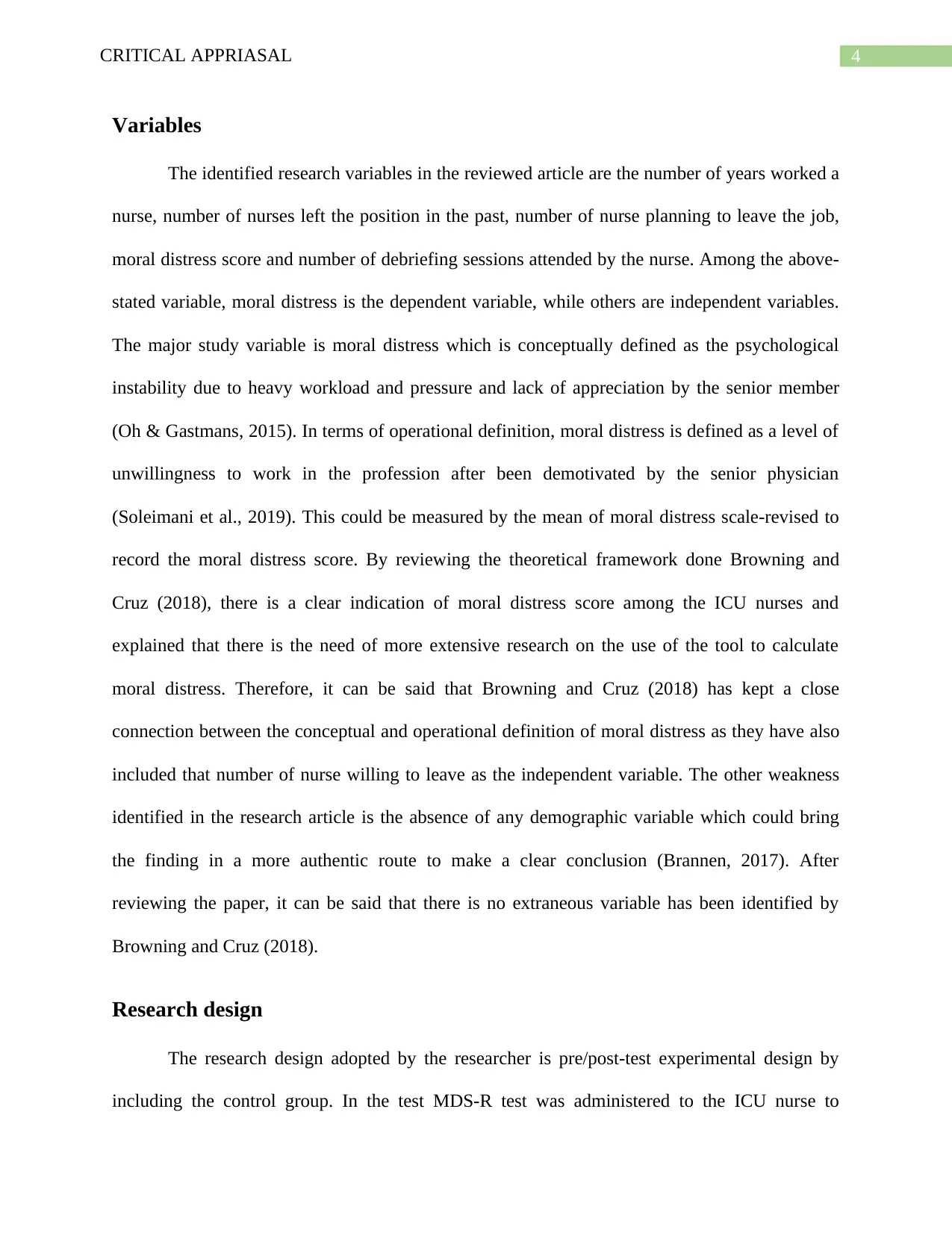
4CRITICAL APPRIASAL
Variables
The identified research variables in the reviewed article are the number of years worked a
nurse, number of nurses left the position in the past, number of nurse planning to leave the job,
moral distress score and number of debriefing sessions attended by the nurse. Among the above-
stated variable, moral distress is the dependent variable, while others are independent variables.
The major study variable is moral distress which is conceptually defined as the psychological
instability due to heavy workload and pressure and lack of appreciation by the senior member
(Oh & Gastmans, 2015). In terms of operational definition, moral distress is defined as a level of
unwillingness to work in the profession after been demotivated by the senior physician
(Soleimani et al., 2019). This could be measured by the mean of moral distress scale-revised to
record the moral distress score. By reviewing the theoretical framework done Browning and
Cruz (2018), there is a clear indication of moral distress score among the ICU nurses and
explained that there is the need of more extensive research on the use of the tool to calculate
moral distress. Therefore, it can be said that Browning and Cruz (2018) has kept a close
connection between the conceptual and operational definition of moral distress as they have also
included that number of nurse willing to leave as the independent variable. The other weakness
identified in the research article is the absence of any demographic variable which could bring
the finding in a more authentic route to make a clear conclusion (Brannen, 2017). After
reviewing the paper, it can be said that there is no extraneous variable has been identified by
Browning and Cruz (2018).
Research design
The research design adopted by the researcher is pre/post-test experimental design by
including the control group. In the test MDS-R test was administered to the ICU nurse to
Variables
The identified research variables in the reviewed article are the number of years worked a
nurse, number of nurses left the position in the past, number of nurse planning to leave the job,
moral distress score and number of debriefing sessions attended by the nurse. Among the above-
stated variable, moral distress is the dependent variable, while others are independent variables.
The major study variable is moral distress which is conceptually defined as the psychological
instability due to heavy workload and pressure and lack of appreciation by the senior member
(Oh & Gastmans, 2015). In terms of operational definition, moral distress is defined as a level of
unwillingness to work in the profession after been demotivated by the senior physician
(Soleimani et al., 2019). This could be measured by the mean of moral distress scale-revised to
record the moral distress score. By reviewing the theoretical framework done Browning and
Cruz (2018), there is a clear indication of moral distress score among the ICU nurses and
explained that there is the need of more extensive research on the use of the tool to calculate
moral distress. Therefore, it can be said that Browning and Cruz (2018) has kept a close
connection between the conceptual and operational definition of moral distress as they have also
included that number of nurse willing to leave as the independent variable. The other weakness
identified in the research article is the absence of any demographic variable which could bring
the finding in a more authentic route to make a clear conclusion (Brannen, 2017). After
reviewing the paper, it can be said that there is no extraneous variable has been identified by
Browning and Cruz (2018).
Research design
The research design adopted by the researcher is pre/post-test experimental design by
including the control group. In the test MDS-R test was administered to the ICU nurse to
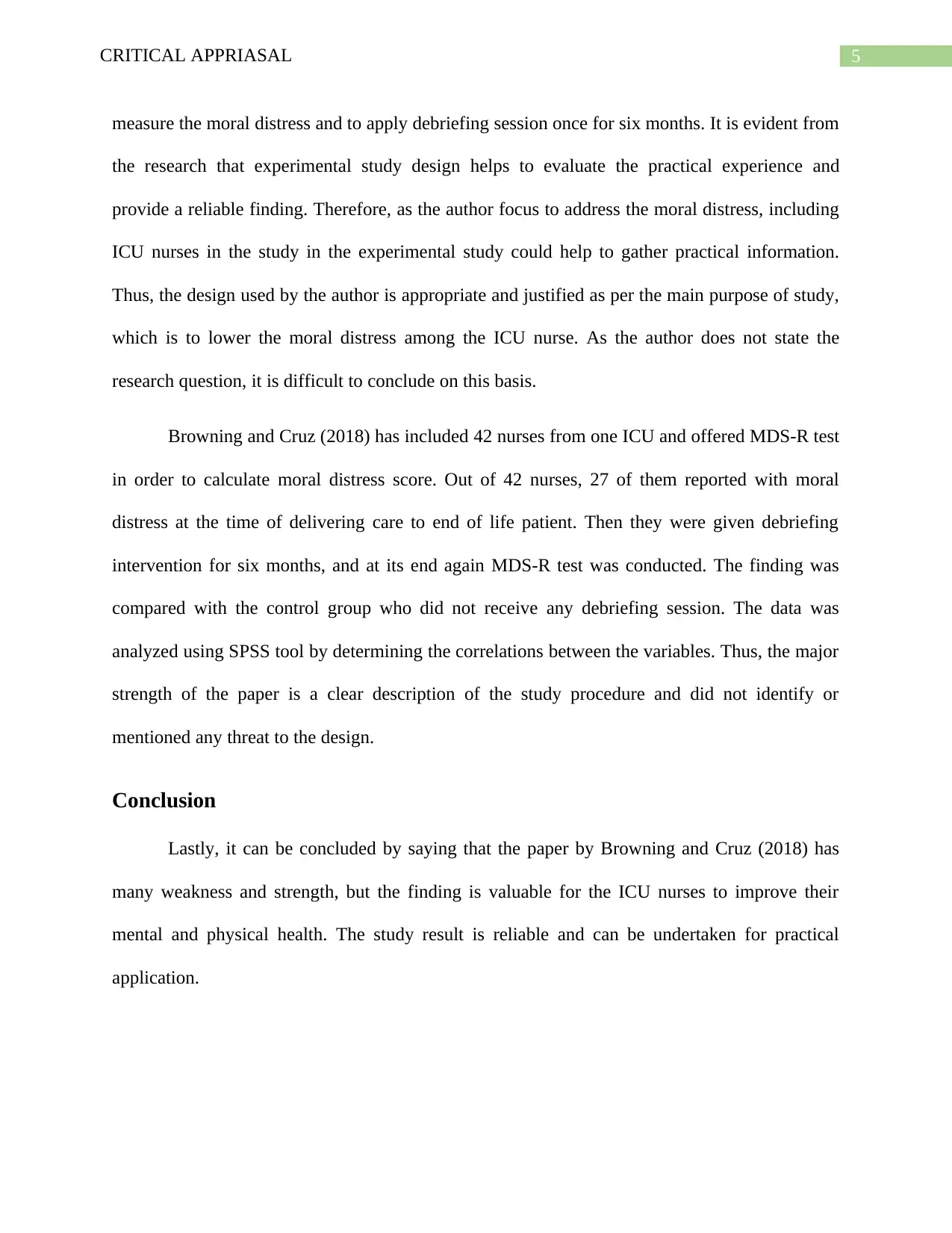
5CRITICAL APPRIASAL
measure the moral distress and to apply debriefing session once for six months. It is evident from
the research that experimental study design helps to evaluate the practical experience and
provide a reliable finding. Therefore, as the author focus to address the moral distress, including
ICU nurses in the study in the experimental study could help to gather practical information.
Thus, the design used by the author is appropriate and justified as per the main purpose of study,
which is to lower the moral distress among the ICU nurse. As the author does not state the
research question, it is difficult to conclude on this basis.
Browning and Cruz (2018) has included 42 nurses from one ICU and offered MDS-R test
in order to calculate moral distress score. Out of 42 nurses, 27 of them reported with moral
distress at the time of delivering care to end of life patient. Then they were given debriefing
intervention for six months, and at its end again MDS-R test was conducted. The finding was
compared with the control group who did not receive any debriefing session. The data was
analyzed using SPSS tool by determining the correlations between the variables. Thus, the major
strength of the paper is a clear description of the study procedure and did not identify or
mentioned any threat to the design.
Conclusion
Lastly, it can be concluded by saying that the paper by Browning and Cruz (2018) has
many weakness and strength, but the finding is valuable for the ICU nurses to improve their
mental and physical health. The study result is reliable and can be undertaken for practical
application.
measure the moral distress and to apply debriefing session once for six months. It is evident from
the research that experimental study design helps to evaluate the practical experience and
provide a reliable finding. Therefore, as the author focus to address the moral distress, including
ICU nurses in the study in the experimental study could help to gather practical information.
Thus, the design used by the author is appropriate and justified as per the main purpose of study,
which is to lower the moral distress among the ICU nurse. As the author does not state the
research question, it is difficult to conclude on this basis.
Browning and Cruz (2018) has included 42 nurses from one ICU and offered MDS-R test
in order to calculate moral distress score. Out of 42 nurses, 27 of them reported with moral
distress at the time of delivering care to end of life patient. Then they were given debriefing
intervention for six months, and at its end again MDS-R test was conducted. The finding was
compared with the control group who did not receive any debriefing session. The data was
analyzed using SPSS tool by determining the correlations between the variables. Thus, the major
strength of the paper is a clear description of the study procedure and did not identify or
mentioned any threat to the design.
Conclusion
Lastly, it can be concluded by saying that the paper by Browning and Cruz (2018) has
many weakness and strength, but the finding is valuable for the ICU nurses to improve their
mental and physical health. The study result is reliable and can be undertaken for practical
application.
⊘ This is a preview!⊘
Do you want full access?
Subscribe today to unlock all pages.

Trusted by 1+ million students worldwide
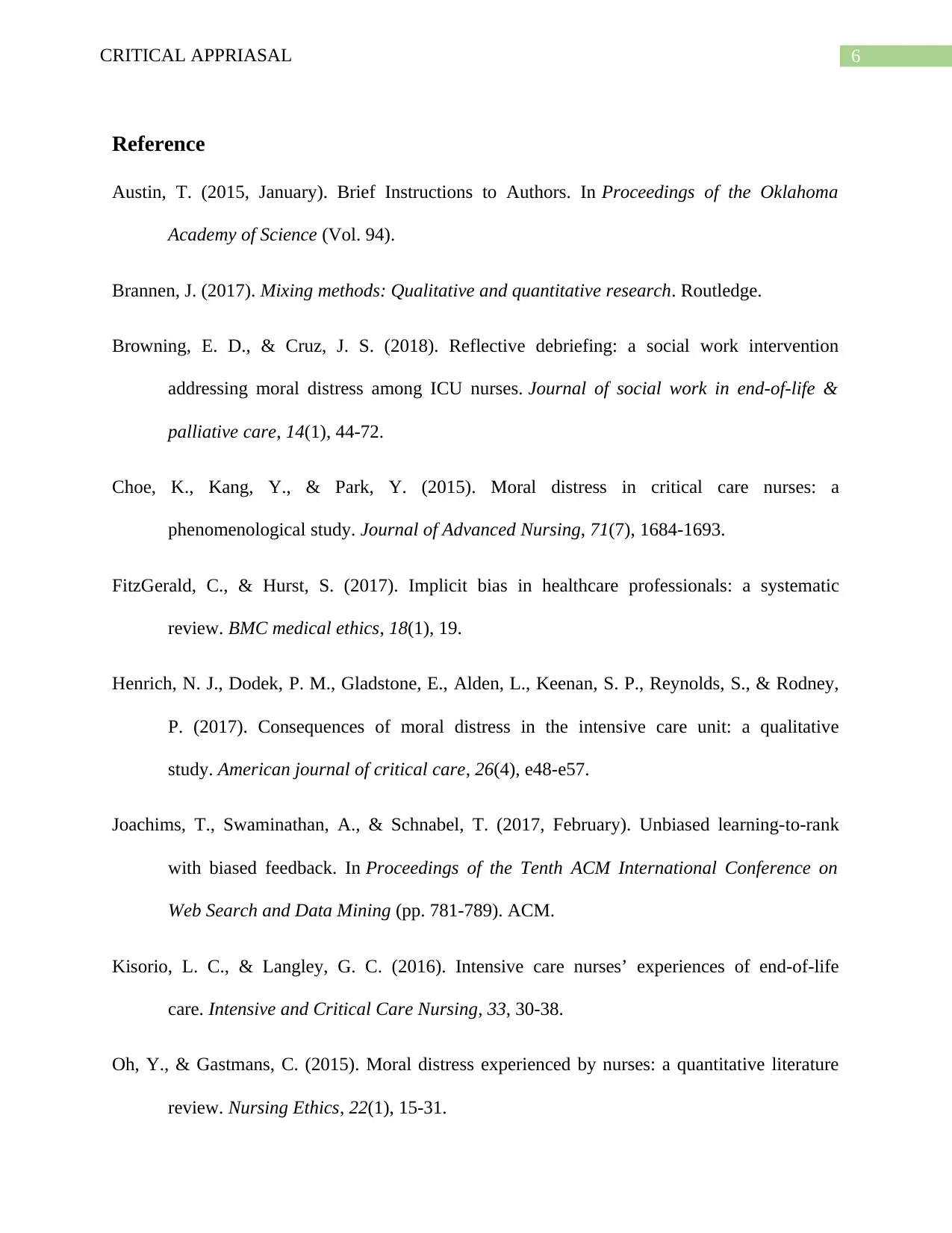
6CRITICAL APPRIASAL
Reference
Austin, T. (2015, January). Brief Instructions to Authors. In Proceedings of the Oklahoma
Academy of Science (Vol. 94).
Brannen, J. (2017). Mixing methods: Qualitative and quantitative research. Routledge.
Browning, E. D., & Cruz, J. S. (2018). Reflective debriefing: a social work intervention
addressing moral distress among ICU nurses. Journal of social work in end-of-life &
palliative care, 14(1), 44-72.
Choe, K., Kang, Y., & Park, Y. (2015). Moral distress in critical care nurses: a
phenomenological study. Journal of Advanced Nursing, 71(7), 1684-1693.
FitzGerald, C., & Hurst, S. (2017). Implicit bias in healthcare professionals: a systematic
review. BMC medical ethics, 18(1), 19.
Henrich, N. J., Dodek, P. M., Gladstone, E., Alden, L., Keenan, S. P., Reynolds, S., & Rodney,
P. (2017). Consequences of moral distress in the intensive care unit: a qualitative
study. American journal of critical care, 26(4), e48-e57.
Joachims, T., Swaminathan, A., & Schnabel, T. (2017, February). Unbiased learning-to-rank
with biased feedback. In Proceedings of the Tenth ACM International Conference on
Web Search and Data Mining (pp. 781-789). ACM.
Kisorio, L. C., & Langley, G. C. (2016). Intensive care nurses’ experiences of end-of-life
care. Intensive and Critical Care Nursing, 33, 30-38.
Oh, Y., & Gastmans, C. (2015). Moral distress experienced by nurses: a quantitative literature
review. Nursing Ethics, 22(1), 15-31.
Reference
Austin, T. (2015, January). Brief Instructions to Authors. In Proceedings of the Oklahoma
Academy of Science (Vol. 94).
Brannen, J. (2017). Mixing methods: Qualitative and quantitative research. Routledge.
Browning, E. D., & Cruz, J. S. (2018). Reflective debriefing: a social work intervention
addressing moral distress among ICU nurses. Journal of social work in end-of-life &
palliative care, 14(1), 44-72.
Choe, K., Kang, Y., & Park, Y. (2015). Moral distress in critical care nurses: a
phenomenological study. Journal of Advanced Nursing, 71(7), 1684-1693.
FitzGerald, C., & Hurst, S. (2017). Implicit bias in healthcare professionals: a systematic
review. BMC medical ethics, 18(1), 19.
Henrich, N. J., Dodek, P. M., Gladstone, E., Alden, L., Keenan, S. P., Reynolds, S., & Rodney,
P. (2017). Consequences of moral distress in the intensive care unit: a qualitative
study. American journal of critical care, 26(4), e48-e57.
Joachims, T., Swaminathan, A., & Schnabel, T. (2017, February). Unbiased learning-to-rank
with biased feedback. In Proceedings of the Tenth ACM International Conference on
Web Search and Data Mining (pp. 781-789). ACM.
Kisorio, L. C., & Langley, G. C. (2016). Intensive care nurses’ experiences of end-of-life
care. Intensive and Critical Care Nursing, 33, 30-38.
Oh, Y., & Gastmans, C. (2015). Moral distress experienced by nurses: a quantitative literature
review. Nursing Ethics, 22(1), 15-31.
Paraphrase This Document
Need a fresh take? Get an instant paraphrase of this document with our AI Paraphraser
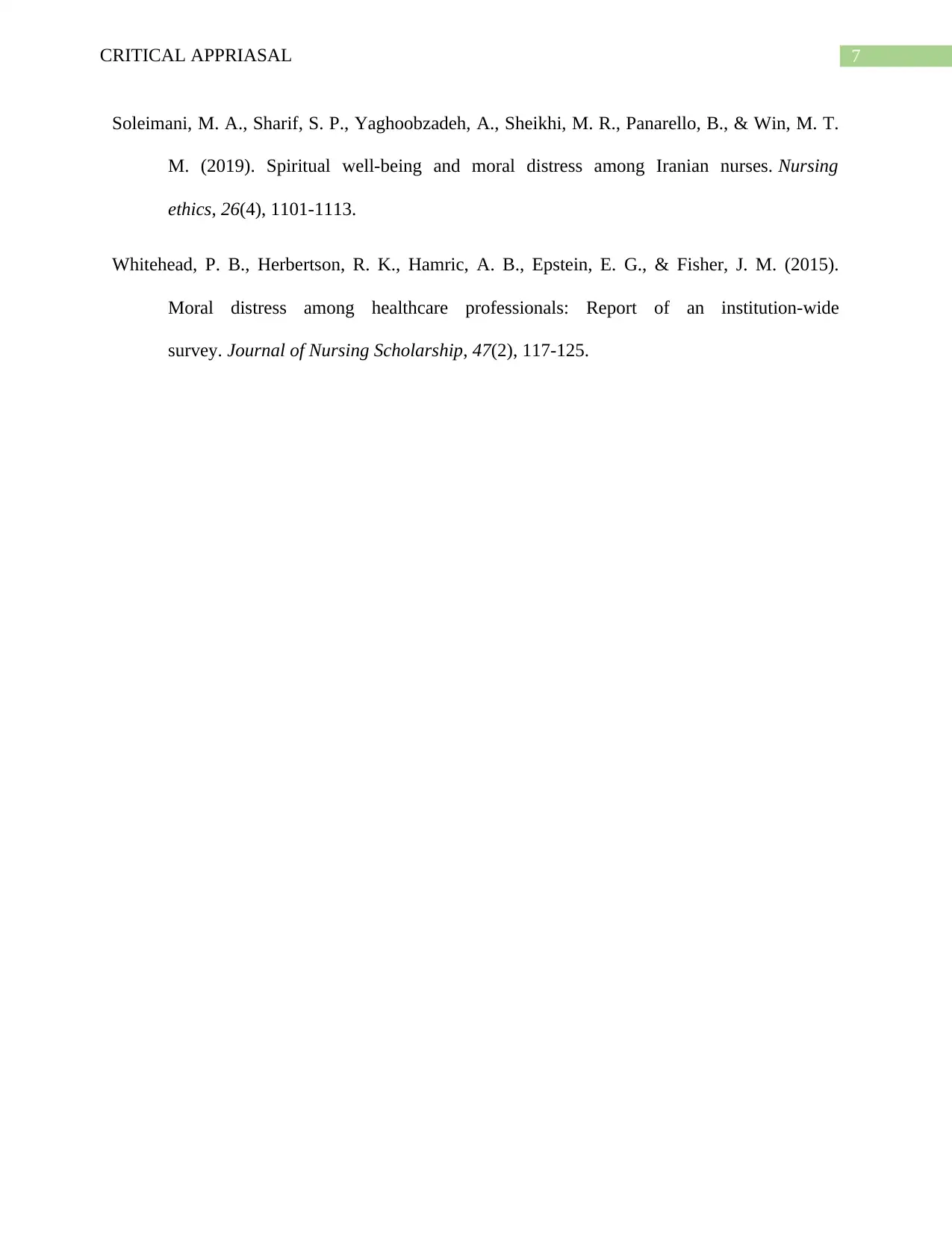
7CRITICAL APPRIASAL
Soleimani, M. A., Sharif, S. P., Yaghoobzadeh, A., Sheikhi, M. R., Panarello, B., & Win, M. T.
M. (2019). Spiritual well-being and moral distress among Iranian nurses. Nursing
ethics, 26(4), 1101-1113.
Whitehead, P. B., Herbertson, R. K., Hamric, A. B., Epstein, E. G., & Fisher, J. M. (2015).
Moral distress among healthcare professionals: Report of an institution‐wide
survey. Journal of Nursing Scholarship, 47(2), 117-125.
Soleimani, M. A., Sharif, S. P., Yaghoobzadeh, A., Sheikhi, M. R., Panarello, B., & Win, M. T.
M. (2019). Spiritual well-being and moral distress among Iranian nurses. Nursing
ethics, 26(4), 1101-1113.
Whitehead, P. B., Herbertson, R. K., Hamric, A. B., Epstein, E. G., & Fisher, J. M. (2015).
Moral distress among healthcare professionals: Report of an institution‐wide
survey. Journal of Nursing Scholarship, 47(2), 117-125.
1 out of 8
Related Documents
Your All-in-One AI-Powered Toolkit for Academic Success.
+13062052269
info@desklib.com
Available 24*7 on WhatsApp / Email
![[object Object]](/_next/static/media/star-bottom.7253800d.svg)
Unlock your academic potential
Copyright © 2020–2025 A2Z Services. All Rights Reserved. Developed and managed by ZUCOL.





